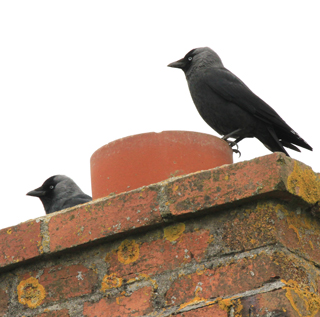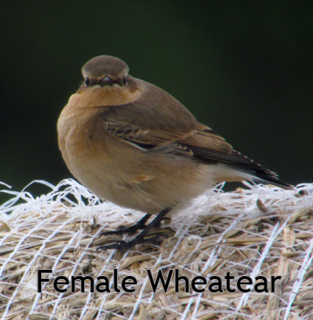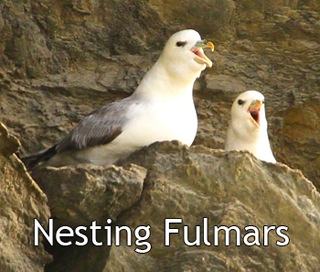 Kaaarr! TchKaaarr! Who said that? Little sooty-black characters are making loud banter on the roof tops, sheltering on the lee side of the pitch, watching and waiting on what everybody else is doing. Jackdaws: They live with us all the year round, adding their cheery chatter to the background of Roseland life.
Kaaarr! TchKaaarr! Who said that? Little sooty-black characters are making loud banter on the roof tops, sheltering on the lee side of the pitch, watching and waiting on what everybody else is doing. Jackdaws: They live with us all the year round, adding their cheery chatter to the background of Roseland life.
Jackdaws (Corvus monedula) are members of the corvid family, which includes Carrion crows (Corvus corone), Rooks (Corvus frugilegus), Ravens (Corvus corax) and Jays (Garrulus glandarius). They are distinguished by their relatively small size and strikingly pale blue eyes. Jackdaws live year round together in large social groups, consisting of many extended families. Like us humans, their social structure requires a complexity of order, commanding deference to increasingly important individuals in the flock’s hierarchy.
Pairs of jackdaws bond for life, beginning breeding activity in their second year together. They prefer to nest in crevices – unusual for the corvid family. This behaviour may have evolved as a means of protecting their own eggs and chicks against predation from other corvids such as Carrion Crows and Rooks, with whom they often associate. There is also the need to protect the nest from other marauding jackdaws.
 Thus it is that chimney pots are favoured nest sites, as well as church belfries and other elevated roof spaces. The nest base is formed with a mound of wedged sticks which, once stabilised, can be furnished with finer materials. Whilst both birds build the initial stages, the female creates the soft nest cup to her own satisfaction. She will lay between 4 and 6 brown-speckled turquoise eggs, which are incubated for just over a fortnight. After hatching, the noisy and demanding chicks will be fed by both parents for a month or so.
Thus it is that chimney pots are favoured nest sites, as well as church belfries and other elevated roof spaces. The nest base is formed with a mound of wedged sticks which, once stabilised, can be furnished with finer materials. Whilst both birds build the initial stages, the female creates the soft nest cup to her own satisfaction. She will lay between 4 and 6 brown-speckled turquoise eggs, which are incubated for just over a fortnight. After hatching, the noisy and demanding chicks will be fed by both parents for a month or so.
Jackdaws generally forage on the ground for a wide range of live invertebrate prey. They will opportunistically take seasonally available foods, such as eggs, fruits, nuts and seeds, as well as food provisioned at garden feeders. Again, like us, their adaptable and omnivorous diet is key to their success. Like other corvids their numbers have increased, despite smaller brood sizes recorded in recent decades.
Jackdaws that have been hand-reared can make entertaining and endearingly loyal companions. Even if given every opportunity to fly away with other wild birds, their keen sense of family or group loyalty binds them to their human carers. The animal behaviourist Konrad Lorenz kept a captive colony of Jackdaws, one of whom, named Tschock, he described as “tame as any dog”.
From his study of the birds he was able to demonstrate that Jackdaws learn new facts quickly and pass on their new found knowledge to others in a group. For example, young, naïve birds have no apparent fear or concept of predators and other life dangers and must be taught these things from their parents and other flock members. Similarly, learning about resources and how to locate them must be learned from older mentors. Lorenz described this knowledge transfer process as “true tradition”, which was being passed between generations.
Among the many characteristics that make Jackdaws endearing creatures is their apparent sense of fun, indulging in aerial acrobatics; they also enjoy surfing and diving in the upcurrents of windy gales along with the herring gulls.
Jackdaws are known to be good mimics, and can even mimic human speech. They also love to possess bright and shiny objects, which they like to collect.
Select a survey square for the BTO House Martin Survey
House Martins (Delichon urbica) are regular visitors to the Roseland coastline. These members of the swallow family are distinguishable by their shortish forked tail, white rump, blue-black upper parts, and bright white underparts. House Martins have already been reported back elsewhere in the UK but are mainly expected by April for nesting in May.
This summer the BTO will be undertaking a House Martin Survey, to estimate the UK population and provide a baseline against which population changes can be measured. House Martin numbers are declining and the species is now amber listed. We need to identify the reason for the decline, using scientific evidence based on data collected by volunteers. This can then be used to work out how the decline can be halted and even reversed.
The BTO are looking for volunteers who are able to make two or three visits to a 1-km square between mid-May and mid-July.You can now view a map of the survey squares and find out more information on the survey here.
 What to look out for this month in the Roseland
What to look out for this month in the Roseland
Of the other migrants expected at this time of year, the first Manx shearwaters and Puffins have already been reported offshore, while the song of Chiffchaffs can now be heard in woodland. Look out for Wheatears too: members of the thrush family, they are not much bigger than robins. Like the Chiffchaff, they spend the winter in Africa, braving the perilous journey back to Britain to breed.
Early nesters such as the Ravens, Fulmars and Shags are well underway with their breeding programme, and Peregrine falcons are displaying well in the skies over the Carrick Roads.
 In the water, a large swarm of Rhizostoma jellyfish was also spotted recently, so watch out for those if you are out on the water.
In the water, a large swarm of Rhizostoma jellyfish was also spotted recently, so watch out for those if you are out on the water.
Britain’s favourite bird – have you voted yet?
According to a YouGov poll, Britain’s favourite bird currently appears to be the Robin, and not surprising considering the characterful presence of these feisty little birds in our gardens. But your vote could change that.
You have until May 7th to vote for your favourite from the shortlist of 10 species. The final results will be passed on to the Queen. Click here to vote now!
References
Arkive.org (2015) Jackdaw. Online document. Accessed 24/03/15. Available from:
http://www.arkive.org/jackdaw/corvus-monedula/
BTO (2008) Breeding Birds in the Wider Countryside. Online document. Accessed 24/03/15. Available from:
http://www.bto.org/birdtrends2008/wcrjackd.shtml
Savage, C. (1995) Bird Brains, the intelligence of crows, ravens, magpies and jays. Sierra Club Books, San Francisco.
Trett, P. (2015) Jackdaw. Birds of Britain online magazine. Accessed 24/03/15. Available from: http://www.birdsofbritain.co.uk/bird-guide/jackdaw.asp
All Photography by Sarah E Vandome, unless otherwise indicated.
Enjoy more Roseland wildlife and landscapes – visit my Heart of Roseland Facebook feature:

